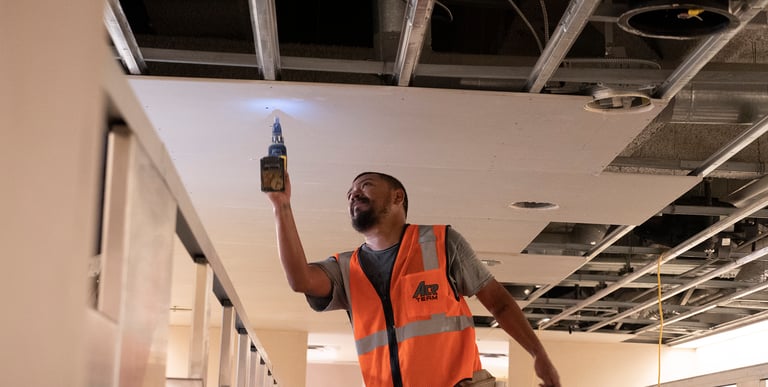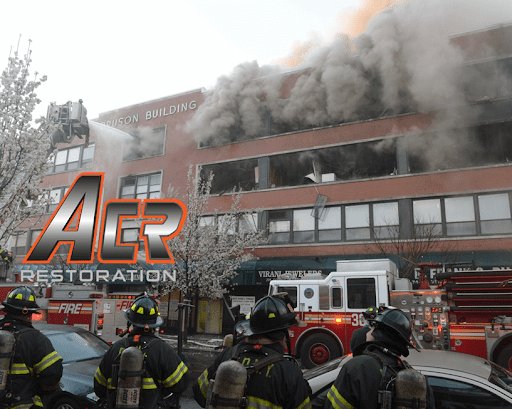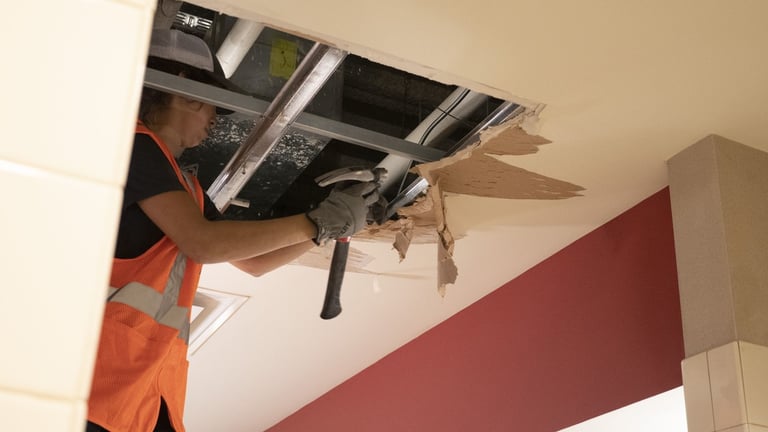Over the last 30 years, ACR has encountered a whole host of complex problems with clients in the commercial property restoration space. Many of these situations can present before or during restoration efforts, and all of them can be compounded by other complexities, such as water intrusion, lack of utilities, and lack of site containment, among others.
What are some situations ACR has faced?
Some of the situations we have faced during remediation efforts in the past include:
- Chemical Spill Cleanups: These involve the removal of toxic, flammable, corrosive, or reactive substances. Chemical spills can pose immediate risks to health and the environment and will require specialized protective gear, documentation, and disposal methods.
- Biological Hazard Cleanups: These cleanups manage biological substances that pose a threat to living organisms, such as blood, bodily fluids, and microbial pathogens. This may include crime scenes, hospital spills, and laboratory accidents.
- Asbestos Abatement: Asbestos is a hazardous material once commonly used in construction. Its removal can release fibers into the air that, when inhaled, can cause serious lung diseases, including cancer.
- Lead Removal: Lead paint and pipes are prevalent in older buildings. Disturbing these materials can release lead dust, which is toxic when ingested or inhaled, particularly for children.
- Mold Remediation: Mold can cause significant health problems, especially in individuals with respiratory conditions or suppressed immune systems. Cleanup often involves working in confined spaces with poor air quality.
- Methamphetamine Lab Cleanup: Chemicals used in the clandestine manufacture of methamphetamine are volatile and toxic. Cleaning up these sites requires dealing with a range of hazardous substances.
- Natural Disaster Response: Cleanups after natural disasters such as hurricanes, floods, and earthquakes often involve dealing with a mix of hazards, including contaminated water, unstable structures, and exposed electrical lines.
- Confined Space Cleanups: Cleanups may take place in environments with limited entries and exits, such as tanks, silos, and sewers, where there is a risk of asphyxiation or exposure to harmful substances.
- Industrial Accidents: Incidents in industrial settings can involve various dangerous substances, heavy machinery, and the risk of structural collapse.
When should I contact local agencies?
Each of these cleanup scenarios requires specific safety protocols, personal protective equipment, specialized training, and often, coordination with emergency services and environmental authorities to manage effectively and minimize risks to cleanup personnel and the public. If you’re faced with any of the above situations, your first call should always be to your local health department. They will guide the response efforts of appropriate contractors.
In addition, they will provide the following important steps and procedures:
- Comprehensive Risk Assessment: Local public health agencies have a profound understanding of community-specific health risks and environmental hazards. ACR project managers may seek this insight and transparency to thoroughly assess risks and plan mitigation strategies together.
- Informed Safety Protocols: Public health agencies provide critical information on safety protocols for handling hazardous materials. ACR will adhere to these protocols to protect workers and residents from exposure to contaminants during cleanup and restoration.
- Guidance on Regulatory Compliance: Contractors often face a myriad of local, state, and federal regulations that govern disaster recovery efforts. Local agencies guide contractors through these regulations, ensuring compliance and helping to avoid penalties or legal action.
- Resource Allocation and Prioritization: Local agencies can help ACR project managers identify the most critical areas in need of restoration. This ensures that efforts are prioritized based on public health importance and environmental impact, leading to more efficient use of resources.
- Certification of Cleanup Efforts: After restoration, ACR will seek verification from local health departments to certify that the affected area is safe to return to. This certification is essential for community trust and for fulfilling insurance and regulatory requirements.
- Training and Development: Public health agencies often offer training and certification programs. ACR uses some of these programs to ensure our employees are up to date on the latest safety practices and cleanup techniques.
- Access to Emergency Preparedness Resources: Local agencies have emergency preparedness and response plans that contractors can integrate into their own operational frameworks. This preparedness is vital for an efficient response to future disasters.
- Effective Communication with the Public: Public health officials are experienced in community outreach and can help contractors communicate effectively with the public about the risks and the steps being taken to mitigate them.
- Building Public Trust: By working with local agencies, contractors can build trust within the community. This is essential for smooth operations, especially in sensitive environments where residents may be distressed or skeptical about recovery efforts.
- Facilitating Insurance and Aid Processes: Public agencies can assist contractors and residents in navigating the complex processes of insurance claims and federal aid, ensuring that recovery efforts are adequately funded and documented.
- Ongoing Monitoring and Health Surveillance: Local health agencies can partner with contractors to monitor environmental conditions and public health following a disaster, ensuring early detection of any residual risks or emerging health issues.
- Networking and Community Integration: Local agencies can connect other contractors with other key stakeholders in the community, such as nonprofits and volunteer organizations, which can be valuable resources during recovery operations.
- Streamlined Permitting and Approvals: Agencies can assist contractors in navigating the permitting process, which can be a significant bottleneck in disaster recovery efforts, ensuring a timely start and completion of projects.
- Enhanced Incident Documentation: Detailed incident documentation facilitated by local agencies is critical for contractors for future reference, liability protection, and historical data collection.
By collaborating with local agencies, ACR can ensure that disaster recovery efforts are not only compliant with regulations but also aligned with the needs and well-being of the community and our clients. Contact us to learn more about commercial restoration and cleaning.





